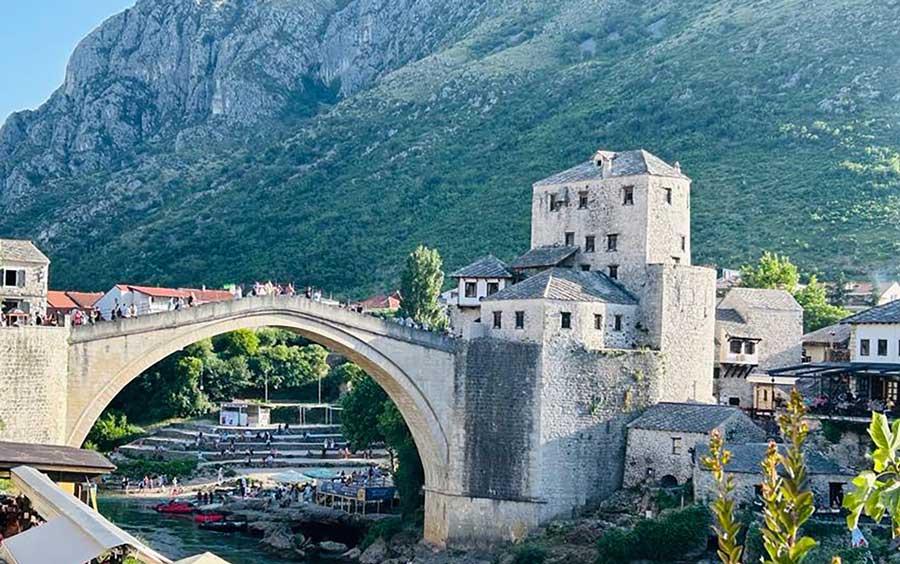
CCCC instructors tour Bosnia and Herzegovina on trip for educators
SANFORD, N.C. — For thousands of years, what is now the nation of Bosnia and Herzegovina has stood at the crossroads of eastern and western civilizations and been part of key developments of world history.
Central Carolina Community College faculty Bianka and Ty Stumpf had the chance to visit the Southeast European country this summer on a 13-day study trip for educators sponsored by UNC-Chapel Hill's Center for Slavic, Eurasian, and East European Studies.
Flight and program expenses were covered by a grant from UNC and the U.S. Department of Education's National Resource Centers.
As the school year unfolds, the Stumpfs plan to share knowledge, insights, and personal experiences from the trip in the classes they teach.
“Students appreciate that our faculty are authentic people, that we are genuine,” said Bianka Stumpf. “They like it and feel connected to us when we open up a part of ourselves.”
At CCCC, Bianka Stumpf’s roles are History & Social Sciences Lead Instructor and Academic & Cultural Enrichment Series Coordinator.
Bosnia, she said, ties into the history she teaches her students in History 112, which covers world history and world civilizations from 1492 onward. From the mid 1400s to the early 1900s, Bosnia was part of the Ottoman Empire, an Islamic state that controlled vast territories across Southeast Europe, Western Asia, and North Africa.
The assassination of Archduke Franz Ferdinand, which sparked World War I, took place in Sarajevo at a site the Stumpfs visited. The history of Bosnia and Herzegovina also relates to U.S. History, another class Bianka Stumpf teaches, through the U.S.’s involvement with the NATO intervention in the Bosnian war in the 1990s.
Stumpf also said she teaches a unit on historiography, the study of the writing of history, that is focused on memorialization. While visiting Bosnia and Herzegovina, she saw many examples she could include.
In the capital, they took a picture of a “Sarajevo Rose,” a type of memorial that was made by pouring red resin into the almost-flowerlike patterns of scars and dents in the concrete made by mortar shell explosions during the siege of Sarajevo in the Bosnian war. Each rose marks lives lost.
“I think that’s a really interesting way to approach a difficult past,” Bianka Stumpf said.
Ty Stumpf is the Chair of the Humanities Department at CCCC. For his teaching of literature, he planned to draw from “Sarajevo Marlboro” by Miljenko Jergovic, a book of short stories about life during the Bosnian war that he read for the trip. The idea, he said, is for students to get an understanding of what literature looks like during wartime in a modern context. He also expected to use some poems he encountered through the trip as examples in his creative writing class.
The Stumpfs saw evidence of a culture of reverence for literature, not just in Sarajevo, a big arts hub, but also in Trebinje, a city the size of Sanford. The poet Jovan Dučić is celebrated all over town there, including in a memorial park in the city center and in a monastery built in his honor.
More broadly, Ty Stumpf planned to reflect with his students on the idea of perspective-taking, which involves understanding a situation or concept from another person’s point of view.
“I think that’s always something interesting about touring or looking into places where you are the outsider for once,” he said. “To be in a place where you see things a little differently.”
Mostar Bridge is a 16th-century bridge in the city of Mostar that was destroyed during the Bosnian war in 1993 and was then rebuilt. It reopened in 2004. Photo by Ty Stumpf.
CCCC faculty Ty and Bianka Stumpf, pictured here in Trebinje, traveled to Bosnia and Herzegovina this summer on a study trip for educators sponsored by UNC-Chapel Hill's Center for Slavic, Eurasian, and East European Studies. Photo by Ty Stumpf.
Public art memorializing the July 1995 Srebrenica massacre. Photo by Ty Stumpf.
Statue of poet and diplomat Jovan Dučić in Trebinje. Photo by Ty Stumpf.